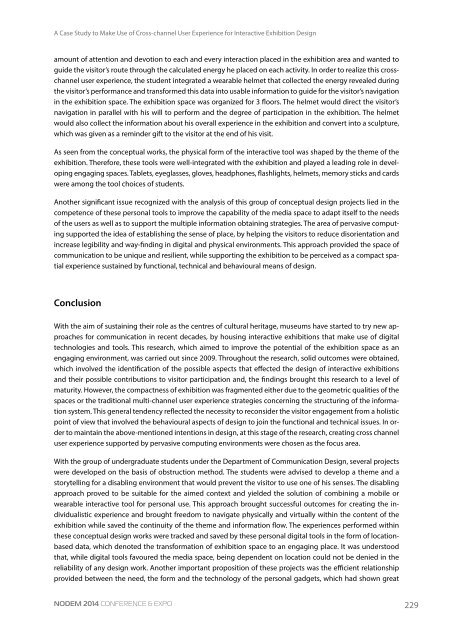NODEM 2014 Proceedings
NODEM 2014 Proceedings
NODEM 2014 Proceedings
Create successful ePaper yourself
Turn your PDF publications into a flip-book with our unique Google optimized e-Paper software.
A Case Study to Make Use of Cross-channel User Experience for Interactive Exhibition Design<br />
amount of attention and devotion to each and every interaction placed in the exhibition area and wanted to<br />
guide the visitor’s route through the calculated energy he placed on each activity. In order to realize this crosschannel<br />
user experience, the student integrated a wearable helmet that collected the energy revealed during<br />
the visitor’s performance and transformed this data into usable information to guide for the visitor’s navigation<br />
in the exhibition space. The exhibition space was organized for 3 floors. The helmet would direct the visitor’s<br />
navigation in parallel with his will to perform and the degree of participation in the exhibition. The helmet<br />
would also collect the information about his overall experience in the exhibition and convert into a sculpture,<br />
which was given as a reminder gift to the visitor at the end of his visit.<br />
As seen from the conceptual works, the physical form of the interactive tool was shaped by the theme of the<br />
exhibition. Therefore, these tools were well-integrated with the exhibition and played a leading role in developing<br />
engaging spaces. Tablets, eyeglasses, gloves, headphones, flashlights, helmets, memory sticks and cards<br />
were among the tool choices of students.<br />
Another significant issue recognized with the analysis of this group of conceptual design projects lied in the<br />
competence of these personal tools to improve the capability of the media space to adapt itself to the needs<br />
of the users as well as to support the multiple information obtaining strategies. The area of pervasive computing<br />
supported the idea of establishing the sense of place, by helping the visitors to reduce disorientation and<br />
increase legibility and way-finding in digital and physical environments. This approach provided the space of<br />
communication to be unique and resilient, while supporting the exhibition to be perceived as a compact spatial<br />
experience sustained by functional, technical and behavioural means of design.<br />
Conclusion<br />
With the aim of sustaining their role as the centres of cultural heritage, museums have started to try new approaches<br />
for communication in recent decades, by housing interactive exhibitions that make use of digital<br />
technologies and tools. This research, which aimed to improve the potential of the exhibition space as an<br />
engaging environment, was carried out since 2009. Throughout the research, solid outcomes were obtained,<br />
which involved the identification of the possible aspects that effected the design of interactive exhibitions<br />
and their possible contributions to visitor participation and, the findings brought this research to a level of<br />
maturity. However, the compactness of exhibition was fragmented either due to the geometric qualities of the<br />
spaces or the traditional multi-channel user experience strategies concerning the structuring of the information<br />
system. This general tendency reflected the necessity to reconsider the visitor engagement from a holistic<br />
point of view that involved the behavioural aspects of design to join the functional and technical issues. In order<br />
to maintain the above-mentioned intentions in design, at this stage of the research, creating cross channel<br />
user experience supported by pervasive computing environments were chosen as the focus area.<br />
With the group of undergraduate students under the Department of Communication Design, several projects<br />
were developed on the basis of obstruction method. The students were advised to develop a theme and a<br />
storytelling for a disabling environment that would prevent the visitor to use one of his senses. The disabling<br />
approach proved to be suitable for the aimed context and yielded the solution of combining a mobile or<br />
wearable interactive tool for personal use. This approach brought successful outcomes for creating the individualistic<br />
experience and brought freedom to navigate physically and virtually within the content of the<br />
exhibition while saved the continuity of the theme and information flow. The experiences performed within<br />
these conceptual design works were tracked and saved by these personal digital tools in the form of locationbased<br />
data, which denoted the transformation of exhibition space to an engaging place. It was understood<br />
that, while digital tools favoured the media space, being dependent on location could not be denied in the<br />
reliability of any design work. Another important proposition of these projects was the efficient relationship<br />
provided between the need, the form and the technology of the personal gadgets, which had shown great<br />
<strong>NODEM</strong> <strong>2014</strong> Conference & Expo<br />
229


